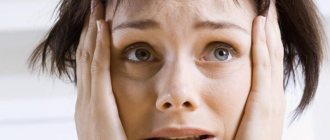Panic attacks at night are sudden attacks of anxiety and fear (most often fear of death) that occur at night or during sleep and are accompanied by severe autonomic symptoms - palpitations, a feeling of shortness of breath, heavy sweating, dizziness. Regular panic attacks are called panic disorder.
The causes of panic attacks during sleep are still unknown. It is believed that they are based on a disruption of the functioning of biologically active substances (norepinephrine and gamma-aminobutyric acid). In 15% of cases, there is a hereditary predisposition when similar conditions occur in close relatives.
A psychotherapist diagnoses and treats panic attacks.
Provoking factors include:
- severe stress, conflicts, childhood experiences and psychological trauma
- abuse of strong coffee, alcohol
- excessive physical activity, mental stress
- hormonal metabolism disorders, injuries and previous infectious diseases of the brain
Less common are panic attacks with two or three symptoms, the so-called minor attacks. They are not accompanied by a feeling of fear and imitate other diseases - heart pathology, dysfunction of the endocrine glands (for example, the thyroid gland).
Such patients have been observed and treated for a long time by therapists, cardiologists and neurologists with a diagnosis of VSD or neurocirculatory dystonia. If treatment from other specialists helps poorly or has no effect at all, you need to consult a psychotherapist.
Be on the lookout!
The psychological dream book compares the dreamed feeling of anxiety with a subconscious feeling of danger. Seeing such a plot for a young lady warns that the sleeping beauty should be wary of new acquaintances and connections with unfamiliar men.
Denise Lin's dream book states that any, especially negative, emotions in a dream are a reason to seriously think about your life. Most often, a dream of fear or anxiety does not predict any specific events, but indicates the current state of affairs of the sleeping person.
Esotericists, interpreting why one dreams of feeling anxious, proclaim the need to be alert and not to trust others too much.
Panic attacks during sleep
Panic attacks differ from nightmares in the time they occur. Night dreams occur in the second half of the night during the REM sleep phase; a person often remembers what he dreamed. Nocturnal panic attacks are not associated with dreams and most often develop from twelve at night to four in the morning.
Panic attacks during sleep have serious negative consequences for a person's health and overall well-being. Attacks prevent the body from resting, disrupt falling asleep, and lead to lack of sleep and constant fatigue.
Important
Panic attacks at night are impossible to forget. A person begins to live in constant fear that this will happen again, and is afraid to go to bed.
Repeated attacks of anxiety and fear at night should alert you and cause you to contact a specialist. Over time, attacks occur more frequently and their duration increases. For example, if at the beginning of the disease there are 1-2 panic episodes every two to three months, then without treatment, attacks can develop daily.
Details: reasons for fear
The Dream Book from A to Z, explaining why you dream of feeling anxious, draws attention to the cause of fear. So, experience excitement for:
- children - foreshadows a change in family relationships;
- work - speaks of the possibility of changing the attitude of management for the better;
- love relationships - announces an upcoming surprise from your significant other;
- unfinished business - promises a collision with unexpected obstacles in work.
Sleep disorders and anxiety
Anxiety is an emotion that arises in response to a situation that threatens a person’s well-being. The anxiety response is determined by the amygdala, which triggers a cascade of reactions that activate neuronal centers in the brain, as well as the hypothalamic-pituitary-adrenal axis. Emotional response is regulated by the prefrontal cortex and hippocampus. Prolonged or frequent anxiety in anxiety disorders leads to functional impairment of the emotion regulation system, a decrease in the volume of the prefrontal cortex and neurogenesis in the hippocampus. Sleep disorders, like any other disease, are associated with increased levels of anxiety. The close proximity of the structures responsible for the regulation of sleep and emotional state determines the high comorbidity of anxiety disorders and sleep disorders. It has been shown that high anxiety is one of the factors of chronic insomnia. The connections between anxiety and movement disorders and sleep-disordered breathing are discussed.
Neuronal connections activated by stress
Definition of Anxiety and Anxiety
Anxiety is a negative emotional state, awkwardness, nervousness, worry about an event with an uncertain outcome. These psychological symptoms are often accompanied by physiological manifestations such as sweating, agitation, trembling, dizziness, and increased heart rate. In contrast to the emotion of fear, associated with a directly impacting, obvious and definite threat to integrity and existence, anxiety is caused by an uncertain, diffuse, objectless threat aimed at a person’s social and personal values, interpersonal relationships, and a person’s position in society [1].
Stress, anxiety and fear reflect psychologically and physiologically similar states of the body, in which the functions of attention and memory are activated in order to process the information that caused this emotional state and form a behavioral response.
A state of anxiety can be normal and enhance adaptation if it occurs in rare situations and does not last long. But in cases where this condition occurs frequently, persists for a long time and begins to interfere with daily activities (work, study, relationships), it becomes pathological.
If the emotion of anxiety characterizes the state of a subject at a certain moment, then anxiety as a relatively stable psychological feature can accompany a person throughout his life. In such people, anxiety occurs more often, is more intense and has a lower threshold for occurrence. There are genetic prerequisites for increased anxiety [2], although the leading role in the development of this personality trait is played by the influence of family and environment. Lack of support for a child (in the family, school, among peers) creates anxiety in adulthood associated with passing exams, interpersonal communication, etc. Increased anxiety creates preconditions for emotional disorders and impaired adaptive capabilities [3].
Physiology and anatomy of anxiety
According to neuroimaging studies, the key center for regulating emotions and emotional reactivity is the amygdala. The structure of the amygdala and its functional activity change in patients with anxiety disorders [4], and also vary depending on personality characteristics affecting the control of emotions [5]. In particular, during painful stimulation, the amygdala is more strongly supplied with oxygen (BOLD signal) in people who more successfully use techniques to control negative emotions [6]. In addition to the amygdala, the prefrontal cortex (PFC), anterior cingulate cortex, striatum and hippocampus are involved in the formation and regulation of emotions.
The formation of an emotional reaction spreads, as it were, from the bottom up: from the ventral nervous structures to the cortical ones. Cognitive processing of information about a potential threat can lead to inhibition of an emotional response if it turns out to be inappropriate to the situation.
The neuronal pathway for the formation of feelings of anxiety is activated in the lateral and laterobasal nuclei of the amygdala, which receive information about possible danger from the senses and memory centers. The neurons of these nuclei activate the central nucleus of the amygdala and the supporting nucleus of the marginal strip. They, in turn, are associated with many structures of the hypothalamus, central gray matter and brainstem nuclei - centers that determine the development of reactions aimed at countering the perceived threat.
The inhibitory reaction, on the contrary, spreads from top to bottom: from the PFC and hippocampus [7, 8]. There are voluntary and involuntary regulation of emotional state. Voluntary involves suppressing emotions, diverting attention from information that causes anxiety, logical revaluation of information about a possible threat and the adequacy of the experienced emotion. These mechanisms are carried out through the dorsomedial and ventrolateral areas of the PFC and the dorsal cortex of the anterior cingulate gyrus. With high productivity of thinking, perception, and memory, people use body-oriented (eating, physical activity, yoga) and intellectualized (logical analysis of the situation, self-analysis) methods of voluntary regulation of anxiety. When low, speech (verbal aggression, communication) and reflexive (internal dialogue, self-persuasion) methods are used. In general, people more often prefer avoidant and passive methods of self-regulation in situations of anxiety, which can lead to its somatization [9]. Involuntary regulation of the emotion of anxiety includes extinction of previous emotional reactions, inhibition of the response of the autonomic nervous system and physiological hyperactivation (through the interaction of the amygdala and ventromedial PFC [10]), automatic shift of attention, automatic cognitive assessment and reappraisal (due to activation of the rostral anterior cingulate cortex [11] ]).
The role of the hippocampus is to provide memory function, as well as involuntary contextual suppression of emotional reactions. Unlike the amygdala, which processes information about any threat, the dorsal hippocampus stores and reproduces information about the situation in which this threat arises. This allows you to differentiate threatening situations from situations with a low or medium level of risk. The inhibitory effect of the hippocampus on the amygdala is mediated by the ventromedial PFC, and in the case of resumption of the suppressed emotional response, by the dorsomedial PFC (Figure [12]) [13].
The amygdala has negative connections with the centers of the septal area, the nucleus accumbens and the ventral tegmental area, which are responsible for positive reinforcement. Thus, the feeling of fear causes a decrease in the feeling of pleasure and vice versa. The ventral tegmental area in turn projects dopaminergic neurons to other parts of the brain, including the PFC.
According to the results of magnetic resonance studies of functional connections in the resting state, normally the activity of the amygdala is positively correlated with the activity of the hippocampus, insula, thalamus, striatum and medial frontal gyrus [14] and negatively correlated with the activity of the superior frontal gyrus, middle frontal gyrus, and posterior angular gyrus. , parietal and occipital regions, which are involved in the processes of cognitive processing of emotions and inhibit the activity of the amygdala.
Anxiety and affective disorders (panic disorder, social anxiety, phobias, generalized anxiety disorder (GAD), post-traumatic stress disorder) are associated with deterioration in the regulation of emotional response in a situation of constant threat. The pathogenesis of these conditions is due to hyperactivation or a decrease in the activation threshold of the amygdala and other structures of the ventral nervous system, which is manifested by increased sensitivity to any negative information. In their development, a disruption of the inhibitory influences of the cortical regions as a result of a decrease in the activity of the medial PFC, as well as a disruption of the connection between the medial PFC and the amygdala, plays a role. In GAD, panic disorder, post-traumatic stress disorder, and social phobia, the deterioration of the differentiation of threatening and safe situations and the resumption of the emotional reaction after its revaluation are of particular importance.
At the level of the body as a whole, the stress reaction associated with the emotion of anxiety activates the hypothalamic-pituitary-adrenal system, as a result, catecholamines and glucocorticosteroids begin to be produced, preparing the body to respond to danger. Acute stress causes an amygdala-mediated release of dopamine in the PFC and an increase in the level of norepinephrine in the PFC due to the activation of locus coeruleus neurons by the amygdala [15, 16]. Increased levels of catecholamines are also associated with blocking their glial glucocorticosteroid transporters. Glucocorticosteroid-sensitive hippocampal cells and the inhibitory action of the medial PFC provide negative feedback to the hypothalamic-pituitary-adrenal axis, stopping the stress response.
Because activation of the hypothalamic-pituitary-adrenal axis plays a central role in stress mechanisms, long-term exposure to anxiety is associated with cardiovascular disease and various metabolic disorders. A constant increase in the level of glucocorticosteroids in the blood leads to a decrease in the differentiation of neurons in the hippocampus and a decrease in its volume [17]. This in turn impairs the regulation of the hypothalamic-pituitary-adrenal axis and contributes to the formation of a “vicious circle”, resulting in further cell damage. In addition, chronic stress leads to a decrease in the release of brain-derived neurotrophic factor, which is necessary for the process of neuronal differentiation and is involved in the effects of the neurotransmitter serotonin [18].
Under the influence of chronic stress, structural disturbances also occur in PFC cells: the number of dendritic spines of pyramidal cells involved in the formation of short-term memory decreases [19]. Other studies note that a decrease in the number of PFC neurons is accompanied by increased growth of amygdala dendrites and an even greater increase in ascending processes of emotional reaction. The impact of chronic stress on neurons of the hippocampus and PFC causes a decrease in their regulatory influences on the emotional reaction induced by the amygdala [20].
A predisposition to disturbances in neuronal connections of the amygdala can be established from childhood. Separation of a child from his mother contributes to the deterioration of connections with the orbitofrontal cortex, insula, hippocampus, putamen, postcentral gyrus, and anterior cingulate gyrus [21]. Genes associated with less stability of amygdala connections under the influence of external stress have been studied [22, 23]. In addition, genes affecting the functioning of the hypothalamic-pituitary-adrenal axis and associated with the development of anxiety-depressive disorders have been identified.
There are hypotheses about the connection between impaired neuronal differentiation in the hippocampus and anxiety-affective disorders, as well as about the implementation of the effect of antidepressants through the restoration of neurogenesis. The association of chronic stress with depression and schizophrenia has been confirmed. In middle-aged women, significant psychosocial stress is associated with the development of Alzheimer's disease over 20 years [24], although the mechanisms of development of persistent cognitive deficits in chronic anxiety have not been studied.
One of the reactions to the emotion of anxiety is the startle reflex (a short-term stereotypic generalized motor reaction - flinching). This reaction is observed in all mammals and has protective significance. There is an inverse relationship between the severity of anxiety symptoms on the Beck scale and the severity of the startle reflex. In addition, blunting of the startle reflex correlates with more frequent stressful events, prolonged exposure to a stressor, multiple psychological and physical traumas, often starting in early childhood, chronicity of the disease, and comorbidity with depressive and other anxiety disorders [25]. Thus, the severity and duration of the disease appears to deplete the neuronal pathways responsible not only for autonomic reactions, but also for the motor response, which is of protective significance.
Experiments on animal models have shown that psychoactive drugs used to correct anxiety-affective disorders reduce cognitive deficits [26], increase the differentiation of hippocampal neurons [27], and restore connections between the amygdala and the above areas [28]. Clinical studies involving patients with anxiety and depressive disorders found that exercise and antidepressants strengthen the functional connections responsible for attention [29], and cognitive behavioral therapy reduces hyperactivation of the amygdala [30].
Sleep disturbances in generalized anxiety disorder
Sleep disorders often accompany GAD. Sleep disturbances were reported by 64% of patients with GAD, while, according to medical history, sleep disturbances developed in 44–73% after the onset of GAD, and before only 16–18%. Anxiety disorder is an independent risk factor for the development of insomnia in both adults (odds ratio 1.39–4.24) and children (2.3–5.5) [31].
Insomnia is included in the diagnostic criteria for GAD according to the DSM-V criteria [3] “Anxiety and agitation caused by three of the following six symptoms, prevailing for six months”:
- restlessness or a feeling of being on edge and on edge;
- fast fatiguability;
- difficulty concentrating or feeling “blacked out”;
- irritability;
- muscle tension;
- sleep disturbance (difficulty falling or staying asleep, or restless, unrestorative sleep).
To distinguish between insomnia as a manifestation of an anxiety disorder and as an independent condition accompanied by anxiety, it is proposed to use the following criteria. Anxiety in GAD is not related to the state of sleep, it is “evenly” distributed over the time of day, and intensifies due to certain events. In insomnia, anxiety increases in the evening and is associated with anticipation of poor sleep or perceived problems in wakefulness following poor sleep (dysfunctional sleep beliefs).
The sleep structure of patients with GAD does not have specific features. Studies have revealed frequent awakenings, an increase in the time of falling asleep and staying awake during sleep, and a decrease in the presence of deep (delta) sleep. These are so-called activation changes, caused by a high level of cerebral activation, observed both in anxiety and insomnia itself. In contrast to GAD, in depressive disorder, the structure of the polysomnogram also shows a decrease in the representation of the REM sleep phase.
For GAD, benzodiazepine anxiolytics are prescribed to eliminate anxiety: diazepam, lorazepam, alprazolam (evidence level A) [32]. The most common anxiolytic in Russia with indications for use in various forms of anxiety disorders is Phenazepam. Benzodiazepine derivatives have an advantage in GAD accompanied by insomnia, since they can correct both disorders at once.
Drugs from other groups also have a high level of effectiveness (level of evidence A) for GAD:
- imipramine (tricyclic antidepressants);
- escitalopram, paroxetine, sertraline (serotonin reuptake inhibitors);
- venlafaxine and duloxetine (serotonin and norepinephrine reuptake inhibitors);
- antipsychotics (quetiapine);
- anticonvulsants (pregabalin).
It should be noted that in case of sleep disorders, treatment with antidepressants should be accompanied by taking drugs with a hypnotic effect, since the clinical effect on sleep when taking antidepressants without sedation does not develop immediately, but within two weeks. At the beginning of antidepressant therapy, the patient may experience anxiety; to overcome the increase in anxiety symptoms in the first two to three weeks, a benzodiazepine anxiolytic, in particular Phenazepam, can be prescribed as a “benzodiazepine bridge.”
Sleep deprivation and anxiety
A high level of anxiety, along with deterioration of attention and increased irritability, constitute the triad of neurobehavioral consequences of sleep deprivation described by W. Dement [33]. A positive correlation has been established between the duration of deprivation and the severity of anxiety. A meta-analysis of studies on the effects of sleep deprivation demonstrated that increased levels of anxiety (as measured by the Spielberger Situational and Trait Anxiety Inventory) were recorded after complete sleep deprivation, but not after sleep restriction [34]. Other effects of sleep deprivation include a decrease in the threshold of sensitivity to stress and more pronounced stress reactions, and impaired processing of information related to emotions (deterioration in the recognition of positive emotions).
Neuroimaging studies during sleep deprivation have demonstrated a decrease in neuronal activity in the area responsible for attention (PFC and intraparietal sulcus) and concentration of attention on the most significant stimulus necessary for the formation of an adequate behavioral response (in the insular and medial frontal cortex). At the same time, there was an increase in activity in the thalamus, in which undifferentiated processing of information coming through all sense organs occurs [34].
The close relationship between anxiety and sleep deprivation has serious consequences. Firstly, in the context of a dynamic modern world, the number of cases of partial sleep deprivation and diagnoses of anxiety disorders is increasing. Secondly, both of these phenomena are independently associated with a variety of disorders of the cardiovascular and endocrine systems. The problem of the connection between sleep deprivation and anxiety is important from the point of view of professional medicine. Insufficient sleep and anxiety are known to independently negatively affect decision-making and other professional competencies [35]. According to the results of the psychomotor vigilance test, after sleep deprivation, patients took longer to make decisions and made more errors. Lack of night sleep significantly increases the risk of errors during work, which is especially dangerous for people in such professions as drivers, pilots, and doctors.
Anxiety in sleep disorders
Insomnia is closely related to anxiety disorders. On the one hand, the risk of developing insomnia in anxiety disorder is 1.39–4.24. On the other hand, insomnia increases the risk of developing an anxiety disorder by 1.43–3.64 times. About 20% of patients with insomnia report symptoms of anxiety or depressive disorder [36]. Thus, insomnia can occur before an anxiety disorder and contribute to its development simultaneously with symptoms of anxiety or debut already in the full picture of an anxiety disorder. Sleep disorders and anxiety disorders can be subclinical for a long time, so it is almost impossible to determine which of the conditions is primary. Personal characteristics such as neuroticism, internalization, perfectionism, and introversion predispose to the development of insomnia disorders [37]. There is also a positive aspect to this relationship: treatment of one of the comorbid disorders has a beneficial effect on the other [38].
The pathogenetic mechanisms of the development of anxiety and insomnia are largely similar. The impact of stress, activating the amygdala, in addition to the emotional reaction, triggers a process of hyperactivation, which also affects the interaction of the centers regulating sleep and wakefulness. With long-term insomnia (more than three months), functional and/or structural changes appear in the structures of the brain:
- decreased orbitofrontal volume [39];
- hypometabolism during wakefulness in the prefrontal cortex on both sides;
- hypometabolism in the cortex of the superior temporal gyrus of the parietal and occipital lobes on the left;
- hypometabolism in the thalamus, hypothalamus and reticular formation;
- hypermetabolism during sleep in the reticular formation, hypothalamus, thalamus, amygdala, hippocampus, medial prefrontal cortex, insular cortex and anterior cingulate cortex [40, 41].
It is important to note that these changes persist throughout the day. This leads to an objective deterioration of short-term, episodic memory and problems in solving problems in patients with chronic insomnia compared to healthy people [35]. Impaired daytime functioning in chronic insomnia appears to be caused by dysfunction of brain structures that are involved in the control of emotional reactions, cognitive functions and hyperactivation (hippocampus, PFC) [42, 43]. Studies have shown that the severity of symptoms of cognitive deficits does not depend on how much sleep patients with chronic insomnia had the night before, in contrast to the control group, in which deterioration in performance on memory and attention tasks was associated with the quality of sleep in the previous nights and daytime sleepiness on the day of the study [35]. Consequently, the nature of the deterioration of memory and attention during insomnia differs from that during sleep deprivation [44].
Anxiety and worry about one’s own sleep affect the patient’s behavior and lead to the formation of a “vicious circle” of self-excitation. The patient's attention is concentrated on everything that poses a potential threat to sleep (own thoughts, mood, environment), as well as on the consequences of a sleepless night (fatigue, drowsiness, decreased performance). Exaggeration of a possible threat to night sleep and the consequences of a sleepless night leads to self-limiting behavior and further fixation of attention on insomnia [9].
Insomnia is an independent risk factor for the development of cardiovascular diseases and metabolic disorders. On the one hand, the close connection between insomnia and anxiety causes activation of the hypothalamic-pituitary-adrenal system. On the other hand, reducing the duration of sleep, especially slow-wave sleep during insomnia, reduces the inhibitory effect on the stress-response system.
The method of choice for treating chronic insomnia is cognitive behavioral therapy. Its main goal is to eliminate dysfunctional sleep beliefs that support unwanted nocturnal hyperactivation of the nervous system. In addition, within the framework of this technique, the patient is taught correct behavior that minimizes the risks of sleep disturbances (compliance with sleep hygiene rules) and increases sleep pressure at the right time. Cognitive behavioral therapy not only improves sleep indicators and reduces the severity of insomnia, but also reduces the severity of anxiety and depressive symptoms. Thus, according to A. Harvey et al. (2007), in patients with chronic insomnia, during cognitive behavioral therapy, scores on the Beck Depression Inventory (-75%) and the Beck Anxiety Inventory (-44%) significantly decreased [45].
However, a meta-analysis of studies examining the effects of cognitive behavioral therapy on anxiety demonstrates low to moderate treatment effects [46]. These data correspond to the results of our own study of the effectiveness of non-drug therapy methods, conducted in the Department of Sleep Medicine of the University Clinical Hospital No. 3. 42 patients with chronic insomnia underwent a two-week course of treatment using a structured methodology combining information, education, relaxation methods and behavioral correction methods ( analogue of cognitive behavioral therapy). Despite a significant decrease in the insomnia severity index by 27% (p = 0.0001) and a decrease in depressive symptoms on the Beck Depression Inventory by 30% (p = 0.04), no statistically significant changes were found during treatment on the Spielberger anxiety scale: situational anxiety decreased by 2.9% (p = 0.58), personal anxiety – by 0.8% (p = 0.82).
At the same time, the high comorbidity of insomnia and anxiety disorders allows us to approach the treatment of insomnia “from the other side” by reducing the severity of anxiety. For this purpose, typical and atypical anxiolytics, antipsychotics, antidepressants and some antiepileptic drugs are prescribed. For acute (lasting no more than three months) insomnia, selective and non-selective agonists of the GABAA chlorion receptor complex are effective. Selective agonists (the so-called Z-drugs: zopiclone, zolpidem, zaleplon), which bind to the alpha subunit of the receptor, are characterized only by a hypnotic effect. Non-selective agonists acting on all subtypes of the GABAA receptor (containing subunits alpha 1, 2, 3, 5, 6) in acute insomnia have, along with hypnotics, a number of additional effects. For anxiety disorders comorbid with insomnia, it is important that the drugs have an anxiolytic effect. It is realized through the binding of drugs to the alpha 2 and alpha 3 subunits of GABAA receptors located in the brain structures responsible for providing responses and generating emotions (amygdala, cerebral cortex, hippocampus, striatum). The use of benzodiazepine tranquilizers, such as Phenazepam, in therapeutic doses helps reduce anxiety levels by 82% [47]. According to the same study, for insomnia comorbid with anxiety disorder, treatment with Phenazepam for 14 days improves sleep indicators by 87%. In a study involving patients with coronary heart disease and neurosis-like disorders who received several benzodiazepine tranquilizers, it was shown that in the anxiolytic effect (70%) Phenazepam was superior to diazepam (62%) and chlordiazepoxide (49%) [48].
Clinical studies have revealed a positive correlation between sleep apnea and anxiety: increased anxiety is observed in 12–17% of those suffering from obstructive sleep apnea syndrome (OSA) [49]. Possible causes of increased anxiety in OSA include insufficient slow-wave sleep and increased levels of cortisol in the blood, which damages the hippocampus, but the influence of other aspects of OSA cannot be ruled out. In particular, predictors of increased anxiety have been established, such as complaints of unrestorative sleep and frequent awakenings at night [50]. Numerous daytime manifestations of OSA (daytime sleepiness, headaches, memory impairment and attention) worsen the quality of life, affecting professional skills, social relationships, and personal life. This creates the preconditions for the development of anxiety-affective disorders of a “secondary” nature.
When conducting neuroimaging studies of patients with OSA, many microfoci of ischemia are detected in the white matter of the brain, caused by damage to the cardiovascular system [51]. In addition, the volume of gray matter in the frontal and parietal lobes, anterior cingulate cortex, basal ganglia and hippocampus decreases [52]. It should be noted that the basal ganglia, in which structural changes were identified, are sensitive to hypoxia. This may explain the disturbances in affective control due to primary ischemic damage to these formations. According to functional magnetic resonance imaging, anxious patients with OSA, in contrast to patients with low levels of anxiety, have more pronounced damage to the ventromedial PFC, insular cortex and uncinus of the hippocampus [53].
With CPAP therapy, the severity of anxiety symptoms decreases three months after the start of treatment [54], which may be explained by the mentioned secondary nature of anxiety disorders in OSA. On the one hand, improving sleep quality contributes to the repair of damage to the basal ganglia, hippocampus and PFC caused by hypoxia and increased cortisol levels. On the other hand, normalizing sleep eliminates other daytime symptoms of OSA, which also cause anxiety.
The pathogenesis of sleep movement disorders remains unclear, so increased anxiety in conditions such as restless legs syndrome (RLS) and periodic limb movement syndrome (PLMS) is considered a secondary symptom that develops in response to disturbances in nighttime sleep. Anamnestic evidence suggests that RLS occurs before anxiety disorders.
Epidemiological studies have revealed an increased risk of developing anxiety disorders in patients with RLS (in 23.2% of patients). Among the anxiety disorders comorbid with RLS, the leading one is panic anxiety disorder (in 16.7% of patients) [55]. The risk of developing anxiety-depressive disorders correlates with the severity of RLS and is highest in subjects who reported manifestations of RLS on a daily basis.
Restless legs syndrome and periodic limb movements during sleep have a high comorbidity. Only 20% of patients with RLS do not have SPD, and this group of patients has a higher risk of developing depressive and anxiety disorders, and a polysomnographic study reveals a higher index of spontaneous awakenings [56]. A polysomnographic study in SPD demonstrated the expected increase in the number of awakenings, changes in sleep stages and the presence of the first stage of sleep. At the same time, mapping of the daytime electroencephalogram showed an increase in the index of alpha-1 activity, which coincides with the electroencephalogram indicators for anxiety disorder. The pathogenesis of these changes remains unclear.
Thus, the results of epidemiological studies suggest the comorbidity of anxiety disorders and sleep disorders. However, if in the case of insomnia the role of increased anxiety is well studied, the mechanism of comorbidity with other sleep disorders requires further research.
Cheer up!
The dream interpreter advises people who dream of a drill to diversify their lives with bright events. Take a vacation, spend time with family and friends, visit exhibitions or museums
The interpretation of a dream about anxiety is sometimes associated with the sleeping person’s dissatisfaction with his life. You think that you live a boring and ordinary life, dreaming of a beautiful and rich life. However, you do nothing to make your desires come true, esotericists are sure.
Prevention of new attacks
Prevention of a vegetative crisis involves developing a set of specific measures that improve the body’s ability to withstand sudden attacks.
- The use of auto-training and other practices to get rid of neuroses, attacks of psychosis and depressive states.
- Increased stress resistance.
- Lifestyle changes: reasonable daily routine, feasible physical activity, nutrition correction.
- Treatment of mental disorders and somatic diseases.
- Periodic course of taking medications with strict adherence to dosage and under the supervision of the attending physician.









